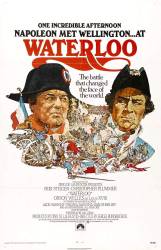Revealing mistake: The cannons shown are firing blank charges, which produce no recoil. Recoil has been simulated by towing the guns backwards when they fire. The problem is, there is always a distinct delay between the discharge and the "recoil." The cannon also seem to largely fire explosive shells. At no point do we actually see a cannon ball rolling or bouncing along the ground or into any group of soldiers.
Revealing mistake: During the battle, both the Allied and French commands spot unknown troops marching towards the battlefield. They are marching through what looks like a wheatfield, following paths which have already been made. However, these new troops are marching on a route so far unused by either the French or Allied armies, so therefore the field should have been untouched - these paths were made on the first take.






Answer: This is decidedly fiction. The historical Ney already published a boastful proclamation (that Napoleon later said disgusted him), declaring the rule of the Bourbons to be over, before he met with Napoleon (March 15). The scene where Napoleon offered himself to be shot had happened several days earlier, with the 5th regiment of the line, before Napoleon even reached Grenoble. It's an entirely different event from Ney's defection.